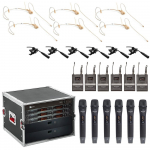- Show results for
- Share
How To Choose The Right Wireless Microphone System?
Resource Description

Wireless microphone systems play a significant role in nowadays production, especially from concerts to business presentations. A wireless microphone system provides proper work for journalists, musicians, or instructors. And most crucial, it offers vocalists and readers to move throughout the hall or stage while operating. With a wireless microphone system, you will no longer need to drill holes for a wired microphone system.
What To Consider While Choosing Proper Wireless Microphone System?
Modern technology offers a variety of selections that match certain needs and situations. When plenty of options make great adjustability, it will be easier to get confused, while selecting the proper device. Several wireless microphone systems demand to be the complete device in use.
Frequency
UHF (400 MHz and more) has been the standard frequency for several years, as it provides the toughest and highest operation. However, the FCC replaced the UHF on the frequencies for proper wireless microphone operation. The complete combination of long transmission distance and clear frequency is from 470 to 548 Mhz bands.
You may also find various microphone systems that function in the 2.4 GHz frequency band. Such wireless microphone systems are far better to use in small rooms with no obstructions between the transmitter and receiver antennas.
Another frequency band applied by the professional wireless microphone system rates from 902 to 928 Mhz. Such frequency rate is common among those who replaced old and outdated frequencies from 600 to 700 Mhz. Several manufacturers may also offer VHF at the rate from 169 to 216 Mhz, which may become a suitable selection, due to new digital technologies.
Operating rate
A general rule is to select a proper wireless microphone system with a stated operating rate twice the distance that is required. The wireless system must provide an operating rate of 1,000 feet or more. Moreover, the operating space should be only 900 square feet and include a few obstructions. Furthermore, short-rate wireless systems generally can’t transit through slight barriers such as desks, doors, or sound booths.
Wireless Microphone System Reliability
The quality of the wireless microphone system depends on the price and elements the system has. Cheaper microphone systems may include unreliable elements and may even lead to certain issues. The proper microphone system should feature low noise and low dropout, that is why be sure that the noise reduction applied in construction is the proper squeezing type. squeezing relates to indicator compression as it passes into the system and the indicator spread comes out. Noise reduction applied by certain systems yields a pumping noise that may be distracting to listeners.
Sound Quality - Digital vs Analog
There are many reasons to select a digital wireless microphone system over analog wireless systems. For instance, battery life, and spectral efficiency are the biggest benefits that improve sound quality.
Analog wireless systems use a compander to press the whole dynamic rate of a voice or musical instrument into the narrow frequency allocation produced for wireless microphone applications.
Digital systems may easily transmit a steady digital indicator that supplies a full dynamic rate without squeezing, resulting in more natural quality sound. Several digital microphone systems will allow you to fix the transmitter from a computer networked to the receiver.
|
|
Wireless Microphone Features
Take a wireless microphone system with features and operations that will profit you most.
Separate Mute and Transmission Switches
One of the most demanded features of the wireless microphone system is separated mute and transmission switches. When the receiver and transmitter communicate, they are locked on the same frequency. Nevertheless, when the receiver and transmitter are off, there will be no transmitted indicator, consequently, the recipient may be able to gather any transmitted indicator on its specific frequency. One stray indicator may damage the operation of the system. Furthermore, with a separate mute switch, a pastor can damp the sound indicator when it doesn't demand to be heard. Its transmission switch may be left on, blocking the transmitter from its receiver thus preventing unwanted stray indicators.
Antenna Diversity
You should note that any wireless microphone system should include two antennas. A single antenna system may lead to dropout. The proper antenna system for the microphone system applies two antennas, that is why when the indicator at one antenna drops out, the other one will gather the indicator. Detachable antennas are a complete indicator of a true diversity system.
Low Impedance, Balanced Line Output
Commercial and professional wireless microphones include balanced output from the receiver for the direct connection to the mixing console. Balanced connections help to reduce or eliminate noise and hum problems with the audio indicator when it leaves the receiver.
Rechargeable Batteries
New systems include high-operation rechargeable batteries that last 10 hours on one charge. They may pass through 1,000 charging cycles, thus saving thousands in battery costs. High-operation digital systems check rechargeable batteries when they are in a charging phase or use. Certain systems may inform you how much time is left for the battery before recharging.
















